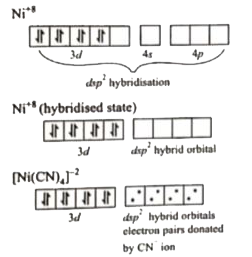[Cr(NH3)6]+3 is paramagnetic while [Ni(CN)4]−2 is diamagnetic explain why ?
(i)Formation of [Cr(NH3)6]+3 : The oxidation state of chromium in [Cr(NH3)6]+3 ion is +3. The electronic configuration of chromium is [Ar]3d54s−1. The hybridisation scheme is shown below :

Ammonia being a weak ligand is unable to pair to up the electrons of Cr+3 and hence Cr+3 undergoes d2sp3 hybridisation.

Thus the complex is inner orbital, octahedral complex and paramagnetic because of the presence of three unpaired electrons.
(ii)Formation of [Ni(CN)4]−2 : In the square planar complexes , the hybridisation involved is dsp2. In [Ni(CN)4]−2 ,nickel is in +2 oxidation state and has the electronic configuration of d8 .

CN− ion being a strong ligand, pairs up the 3d electrons leaving one 3d orbital vacant that is used for dsp2 hybridisation.

Thus the complex is diamagnetic as there are no unpaired electron.
Topper's Solved these Questions
- CO-ORDINATION CHEMISTRY BOOK - PREMIERS PUBLISHERSCHAPTER - CO-ORDINATION CHEMISTRY EXERCISE - Other Important Question & Answer (Choose the correct Answer)
30 Videos
- CHEMISTRY IN EVERYDAY LIFEBOOK - PREMIERS PUBLISHERSCHAPTER - CHEMISTRY IN EVERYDAY LIFEEXERCISE - OTHER IMPORTANT QUESTIONS& ANSWERS (ANSWER THE FOLLOWING QUESTIONS)
63 Videos
- ELECTRO CHEMISTRYBOOK - PREMIERS PUBLISHERSCHAPTER - ELECTRO CHEMISTRYEXERCISE - OTHER IMPORTANT QUESTIONS & ANSWERS (II. Answer the following questions: )
58 Videos
Similar Questions
Knowledge Check
Give reason for the statement [Ni(CN)4]2− is diamagnetic while [NiCl4]2− is paramagnetic in nature .
AIn [NiCl4]2− no unpaired electrons are present while in [Ni(CN)4]2− two unpaired electrons are presentBIn [Ni(CN)4]2− , no unpaired electrons are present while in [NiCl4]2− two unpaired electrons are present .C[NiCl4]2− shows dsp2 hybridisation hence it is paramagnetic .D[Ni(CN)4]2− shows sp3 hybridisation hence it is diamagnetic .Give reason for the statement [Ni(CN)4]2− is diamagnetic while [NiCl4]2− is paramagnetic in nature .
AIn [NiCl4]2− no unpaired electrons are present while in [Ni(CN)4]2− two unpaired electrons are presentBIn [Ni(CN)4]2− , no unpaired electrons are present while in [NiCl4]2− two unpaired electrons are present .C[NiCl4]2− shows dsp2 hybridisation hence it is paramagnetic .D[Ni(CN)4]2− shows sp3 hybridisation hence it is diamagnetic .
How would you account for the following :
[Fe(CN)6]3− is weakly paramagnetic while [Fe(CN)6]4− is diamagnetic
View Solution(i) Write the geometrical isomer of the complex [Co(en)2Cl2]+ .
(ii) [NiCl4]2− is paramagnetic while [Ni(CN)4]2− is diamagnetic through both are tetrahedral . Why ?
View SolutionHow will you account for the following :
(i) [Fe(CN)6]− is weakly paramagnetic while [Ni(CN)4]2+ diamagnetic.
(ii) [Ni(CO)4] possess tetrahedral geometry while [Ni(CN)4]2− is square planar.
View Solution(a) What type of isomerism is shown by the complex [Co(NH3)5(SCN)]2+?
(b) Why is [NiCl4]2− paramagnetic while [Ni(CN)4]2− is diamagnetic ? (Atomic number of Ni=28)
(c) Why are low spin tetrahedral complexes rarely observed?
View Solution[Ni(CN)4]2− is diamagnetic while [Cr(NH3)6]3+ is paramagnetic. Explain.
View Solution(a) What type of isomerism is shown by the complex [Co(NH3)5(SCN)]2+?
(b) Why is [NiCl4]2− paramagnetic while [Ni(CN)4]2− is diamagnetic ? (Atomic number of Ni=28)
(c) Why are low spin tetrahedral complexes rarely observed?
View Solution
